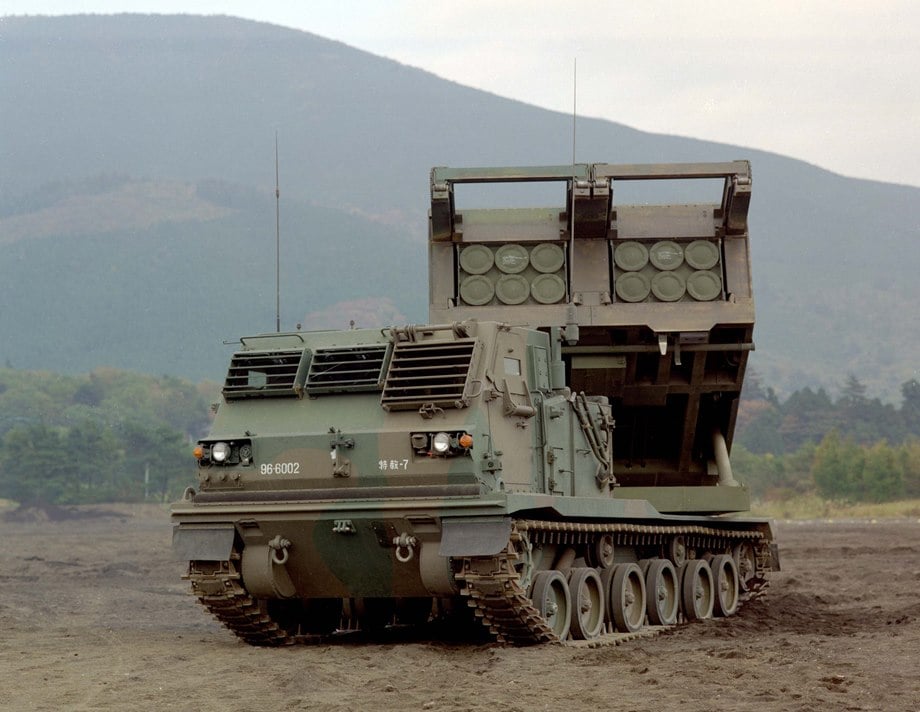 In the 1970 – 1980s, Soviet designers created the powerful jet system of volley fire MLRS, the superiority of which was recognized by military professionals worldwide. Under their influence, many States were later developed by modern samples of this powerful weapon.
In the 1970 – 1980s, Soviet designers created the powerful jet system of volley fire MLRS, the superiority of which was recognized by military professionals worldwide. Under their influence, many States were later developed by modern samples of this powerful weapon.
Currently, such systems are considered effective means of field artillery of the land connections. Their advantage in surprise attacks in combination with a high density of fire for area targets, the ability to rapid fire maneuver, high mobility launchers themselves. At the same time they are simple structures, and relatively low cost with the organization of serial production.
Modern MLRS can cause significant lesions distributed on the areas of manpower of the opponent, to destroy command posts, communications centers, air defense. In addition, one of their main tasks is to fight with tanks, other armored equipment. For this warhead on their missiles often are loaded with homing cluster cumulative elements.
In the mid-1970s in the United States began to develop military jet system of volley fire of the so-called common support weapons designed for divisions and corps. Through several years joint efforts of renowned companies Boeing, Emerson Electric, Martin Marietta (“Boeing”, “Emerson-electric”, “Martin Marietta”) and the other was presented prototypes of launchers and unguided missiles to test the missile test site Waite Sands (White Sands) in new Mexico.

Rocket multiple launch rocket system M270 MLRS is in the stowed position. Curb weight combat vehicles of 25.2 tons, engine power Cummins VTA-903 – 500 HP

Combat vehicle MLRS MLRS М270

Brancolina installation. In the foreground of the display of the fire control system

Launcher loader module М269 with two containers. In each of these six shells. In the upper part of the console mechanism perezarazhenie
In 1978, the U.S. military leadership has changed the direction of the further development of a system to allow its release not only in the US but in other countries, including in Europe. A new programme called MLRS (Multiple Launch Rocket System – “multi-charge launchers multiple rocket launchers”). The head firm in 1980, was elected Texas Lockheed Martin Missiles.
In 1983, the reactive system of volley fire MLRS М270 adopted and she began to enter the army. By the fall of 1995, which consisted of 857 launchers, and 772 of them in the army and 185 to the National guard units.
System М270 was put in batteries and battalions of field artillery of the army units. In each division they were 9 units in buildings – for 27. Significant changes in the structure of the U.S. divisions began to occur after the beginning of the 1990s, when the army of the country began to reorganize in accordance with the adopted program, “Army 21”. The programme will run until 2015, provided for the reorganization of the “heavy” (mechanized and armored) connections that form the basis of the land forces, with the aim of creating more flexible, possessing high vitality groups are able to successfully resist any enemy.
In 2002 was created the first “computerized” connection (“division XXI century”) of the army, approved by its organizational structure. Artillery reorganized division significantly strengthened, particularly regarding MRL: it has replenished with rocket artillery division trehmetrovogo composition – 6 launchers in each battery (total of 18 units instead of 9).
In the course of the events, in particular, provides that: all divisions (for 19 thousand personnel) to translate on a team basis, which is much more compact and, according to American experts, the greatest degree satisfies the requirement to improve the efficiency of command and control. But a large number of rocket launchers М270 remains unchanged.
In 1989 to equip the countries of NATO such weapons, the United States, England, Germany, France and Italy organized an international group manufacturing and started a joint production system.
Currently М270 is a standard rocket system, NATO. Worldwide, their number has, according to some sources, a few more than 1000 units, on the other – to 1300. Them is made from 750 thousand to 1 million shells.

The layout of the MLRS:
1 – brankovina; 2 – remote fire control; 3 – information; 4 – antenna; 5 – mechanism of reloading module; 6 – actuator pointing at elevation angle; 7 – frame module; 8 – block elektrozapalom; 9 – castle-stopper; 10 – wheel driven chassis; 11 – missile; 12 – unit system of control run; 13 – transport-launch containers; 14 – rotary platform; 15 – fixed base; the 16 – base chassis M2; 17 – drive wheel chassis

Unguided missiles:
1 – fuse; 2 – cassette warhead; a 3 – shaped-charge fragmentation submunitions; 4 – polyurethane block elements M77; 5 – fuse engine; 6 – exhaust pipe; 7 – blade stabilizer; 8 – solid-fuel starting the engine; 9 – nakalyvanie nozzle

TZM М985 MLPS

Transport-loading vehicle М985 (8×8) with transport-launch containers missiles

TZM is equipped with a rotary cranes for loading and unloading of containers; curb weight of the containers 2.3 t

Shooting a single rocket projectile

Filling launcher combat vehicle through the mechanism of perezarazhenie

Launcher М270 in firing positions ready to fire. Operation “desert Storm”, Iraq – Kuwait, 1991
For the period 2007 – 2010 the US army consisted of 830 units MLRS in Germany – 130, Japan – 100, FA – 63, Israel 60, France 55, Greece -36 etc MLRS М270 was at that time in 15 countries.
The composition of MLRS MLRS includes; war machine launcher (PU), transport and loading vehicle (TLV), transport-launch containers (TPK), of course, jet 227-mm projectiles, as well as the equipment of fire control.
The launcher is a self-propelled chassis on which is mounted an artillery unit. Chassis – a modified long undercarriage crawler infantry fighting vehicle M2 Bradley (“Bradley”), with the name and the index of “cargo Transporter М993”. Artillery unit consists of a fixed base on the body chassis with tilting frame and gidrostabilizirovannoy rotating platform with an oscillating part of the guidance mechanisms for elevation and horizon, fitted with electrohydropulse. It has traditional rails of conventional MLRS: the swinging part is the launcher loader module М269 (PZM), in an armored box-farm, which are two of the WPK, as well as the mechanism of reloading.
For vertical guidance module is the lift of the two screw stops, driven by pairs of bevel gears with motors.
In transport-launch containers are inserted into aluminum bags with six fiberglass tubular guides each (that’s where they are!), informing the rotation of the projectile with a frequency of 10 to 12 rpm, which ensures its stability in flight and also eliminating the influence of the eccentricity of the thrust.
To embed TLC in the module itself in its front part there is a mechanism of reloading: pull-out console with a winch. Mounted in a package container is fixed by three clamping grips and mechanical locks.
Filling the containers with shells occurs at the factory; there they are sealed, ensuring safety and service life up to 10 years. As a result, prelaunch processing of such shells is not required: set TLC in the launcher module, introduced in the apparatus fire control firing data, that is, “aim” – and command – “fire!”
Ammunition MLRS MLRS includes several types of unmanaged 227-mm rockets with solid-fuel booster engines, warhead (warhead) with a fuse, four stabilizers, the drop-down in flight. Them developed a cluster warhead: shaped-charge fragmentation and anti-tank mines.
Cumulative fragmentation warhead contains 644 submunitions M-77 located around the explosive charge. They are supplied with the shells M26 with a range of 32 km or М26А1/A2 was increased to 45 km range. Combat elements Packed in the nests of cylindrical polyurethane blocks inside a thin-walled aluminum casing. After deployment, the head of the fuse in the terminal phase of the trajectory the housing head portion is discarded and combat elements scatter to the sides. Detonation of submunitions M77 happens when meeting with an obstacle. Due to the fragments obtained by crushing steel case, provided the impact on manpower within a radius of 4 m. the Possibility of destruction of equipment is provided by the cumulative jet; a top – up to 100 mm.
In the anti-tank warhead are protivodnischevyh 28 anti-tank mines at-2 in seven containers, designed for remote installation minefields. For them, developed a projectile M28, with a range of 40 km When approaching such a projectile to a given area at an altitude of about 1200 m from the warhead are ejected containers which are then fired mines, descending by parachute and fill the area. According to some foreign reports, the volley launchers with shells M28 creates a minefield with an area of 0,4×1 km from the Piercing action of the mines at-2 – 100 – 140 mm.
Mass and the other CU – 159 kg and 107 kg, respectively, the mass of the projectiles so – 310 lbs or 258 kg, respectively, the length – 3960 mm.
Apply guided missiles. So, the M30 GMLRS (Guided and controlled) are equipped with inertial guidance unit using the global system for GRS. This shell also has cumulativenormal cluster warhead with 404 elements M77; weight 308 kg, length – 4000 mm, firing range – 70 km.

М270 MLRS the MLRS is the army of Germany on the training ground

Transport of combat vehicles М270 on the conveyor-tractor. London, Heathrow airport, 2008.

System MLRS MLRS includes the service of transport-charging machines M-1075 (10×10) with trailers М989. On each train carrying 48 rockets ammunition
There is also information on designing a managed ХМ29 projectile with cluster warhead, curb anti-tank guided missiles with homing heads. Missiles are ejected from the magazines over the tank column, or simply places of their accumulation, and then hit the machine at the top, less protected part of the hull or turret. The weight of its warhead of the projectile – 111 kg.
All equipment fire control mounted in the cab. Basic elements of information electronic computer, navigation and topographic location, control panel. Provided input adjustments for meteorological and ballistic conditions of firing, the determination of the coordinate location of the PU using the global positioning system GPS, the calculation of initial data for firing, selection of type of fire – salvo or single shells, etc. All calculation and other necessary information is reflected on the display. It is possible to pair the instrument with the upstream automated fire control of field artillery.
Aiming of the launcher is performed by the operator with electrohydraulic actuators, with no need to perform operations on the entire levelling PU: the necessary amendments are automatically entered into the control equipment.
In the cab are the jobs of the three man crew: commander, driver and gunner. She is armored, Soundproofed and have heating and ventilation, equipped with vozduhonagrevatelej to exclude the ingress of gas and dust when shooting. Windows – bulletproof glass on the Windows, shutters and armored shields. In the roof – hatch for view, ventilation and evacuation. Installed infrared night vision devices.
Under the cab is 8-cylinder diesel engine /TA-903 of the firm “Cummins” turbo; its power – 500 HP
The transmission is a hydromechanical NMRT-500 company General electric.
Crawler suspension has six road wheels with hydraulic shock absorbers and two supporting roller on Board. Drive wheels – front. Two fuel tanks with a total capacity 618 l located in the rear of the base plate artcast.
Weight of the launcher without ammunition – 20 of 189 kg, with shells -25 191 kg Max road speed – 64 km/h on rough terrain – up to 48 km/h, power reserve -485 km.
MLRS is airborne aircraft air force C-141, C-5 and C-17.
Each М270 MLRS is served by two freight-loading machines М985 (8×8) or a new M-1075 (10×10) with trailers. These TLV are 10 four-wheel-dannymi trucks with engines of 450 – 500 HP with swivel cranes that can lift cargo up to 2.5 tons On each of the machines and the trailer carried four transport-launch container. The total ammunition one launcher is 108 shells, including 12 around the PU.
In the early 2000s, the installation MLRS modernized to ensure a more rapid preparation for shooting and less time reloading. Not paid attention to and reduce costs of operation and maintenance For this PU is equipped with an advanced fire control system with full display of information, the new keyboard, storage device larger than 1 GB, the modern GPS navigation equipment, an improved mechanical guidance system launcher. In addition, put it on the car built-in system diagnostics and fault finding. A modernized version of the received index М270А1.
Later combat vehicle is still equipped with protection in the form of a lattice and add-on armor, additional bookings bottoms, vzryvozashchity seats for the crew, two additional monitors for the commander and driver, air-conditioning in the cockpit and a machine gun.
Have the MLRS and battle your way. Rocket launchers were used by the Multinational forces during operation “desert Storm” against Iraq in 1991 Then, the United States was taken in Kuwait about 190 combat vehicles (according to others – 230) and 16 units deployed to England. Almost 10 thousand unguided rockets were fired at the Iraqi artillery and air defense systems, clusters of armored vehicles and cars, manpower, helipad.
The use of MLRS in combat operations, the military command concluded that a relatively small-range shooting and low efficiency elements M77 warheads of shells against armored targets. However, the military decided that the MLRS was the only field artillery system, capable of extremely beneficial to participate in the battle together with tanks Abrams, infantry combat vehicles “Bradley”, another armored vehicles, and especially to communicate with tactical aircraft to obtain timely information about the enemy targets.
In 2007 the British to strengthen its contingent in Afghanistan was transferred here a number М270 by expanding them in the Helmand province. They used to fire guided missiles GMLPS, having made over 140 starts. According to the participants, targets at a distance of 70 km was amazed at their “stunning accuracy”.
Currently MLRS М270 and М270А1 are common not only for the U.S. army and other NATO armies. And for the next years are multi-million dollar contracts with the countries of the bloc. Greatest “demand” use of upgrade kits, MLRS, GMLRS guided missiles, training missiles, equipment for ground maintenance.
PERFORMANCE CHARACTERISTICS RST MLRS М270
Crew, persons……………………………………………3
Combat vehicle weight, kg:
without shells………………………………20 190
with shells……………………………..25 190
Dimensions in traveling position, mm:
length…………………………………………..6970
width………………………………………..2970
height………………………………………….2620
In firing position, mm:
height………………………………………….5925
Ground clearance, mm……………………………………..430
Track width, mm………………………533
The reference length caterpillars, mm 4330
Engine……………8-cylinder diesel
Cummins VTA-903 gas turbine supercharged 500 HP
Maximum speed, km/h
on the highway………………………………………….64
cross country……………..48
The amount of fuel l………………………………618
Reserve, km…………………………………..485
Acceleration from 0 to 48 km/h, ……………………..19
Overcoming obstacles in m:
the height of the wall…………………………………1,0
the width of the pit……………………………………2,29
fording depth……………………………….1,10
Preparation for shooting after class
firing position, min……………………………2
Elevation
guidance, hail………………………..- 2 – +55
The corners of the horizontal
guidance, hail…………………………..+ – 140
A full volley with……………………….60
The number of TPK, the PCs…………………………….2
The number of missiles in TPK, the PCs……………6
Dimensions of TPK, mm:
length…………………………………………..4166
width………………………………………..1051
height……………………………………………837
Mass TPK, kg:
without shells…………………………………..411
with shells………………………………..2308
Full ammunition PU
TZM and trailers, PC…………………………..108
V. TALANOV



